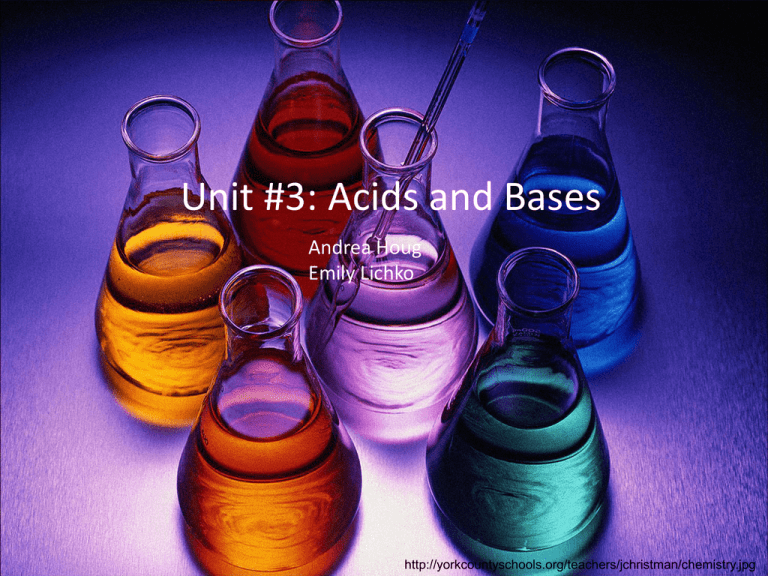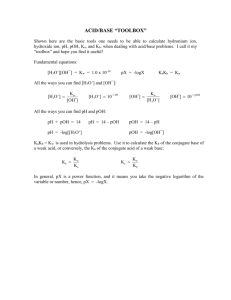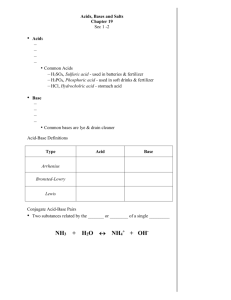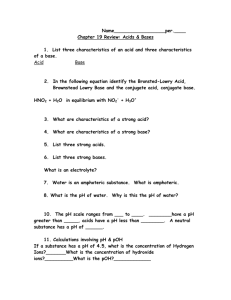Brönsted-Lowry Base
advertisement

Unit #3: Acids and Bases Andrea Houg Emily Lichko http://yorkcountyschools.org/teachers/jchristman/chemistry.jpg Definitions of Acids and Bases •Arrhenius Acid = releases an H+ •Arrehenius Base = releases an OH•Brönsted-Lowry Acid = proton donor •Brönsted-Lowry Base = proton acceptor •Lewis Acid = electron acceptor •Lewis Base = electron donor Lewis Brönsted - Lowry Arrhenius Dissociation •The strength of an acid or a base depends on how much it dissociates in water •Kw = Ka•Kb= 1E-14= [H+][OH-] •EX: Acetic Acid’s Ka = 1.8 E-5. Kb = Kw/Ka = (1E14)/(1.8E-5) = 5.6 E -10 •Strong Acids dissociate 100% •Weak Acids typically dissociate less than 5% H • % dissociation = HA 100% •The stronger the acid or base, the weaker its conjugate Strong Acids Strong Bases eq 0 HCl Alkaline metals with OH- HBr Ca(OH)2 HI Sr(OH)2 HNO3 Ba(OH)2 H2SO4 HClO4 http://myphlip.pearsoncmg.com/phproducts/student/ ab2page.cfm?vbcid=9029&vid=10007#oa231470 Neutralization •Combining an acid with a base produces water and a salt •For strong acids and bases: •NH+CaVa = NOH-CbVb •EX: How much 0.3000M NaOH is needed to neutralize 23.98mL of 0.8000M HNO3? Answer: (1)(0.8000M)(23.98mL) = (1)(0.3000M)(x) X= (0.8000M)(23.98mL)/(0.3000M) =63.95mL HCl http://www1.istockphoto.com/file_thumbview_approve/2 679899/2/istockphoto_2679899_strong_man.jpg Calculating pH 14-pH = pOH 14-pOH= pH [H+] pOH -log [OH-] =pOH -log [H+] =pH pH 1 E-14 / [H+] = [OH-] 1 E-14 / [OH-] = [H+] [OH-] Henderson-Hasselbalch equation base pH pK a log acid pOH http://www.nku.edu/~russellk/TV/simon.gif acid pKb log base Titrations Strong acid / strong base Weak acid / strong base Polyprotic acid / strong base Back Titration: when base is not very soluble, dissolve in excess acid and titrate back with base until excess acid is used up (endpoint) http://www.sparknotes.com/chemistry/acidsbases/titrations/section1.html ICE chart EX: pH of original 0.100 weak acid solution, Ka given HA + I 0.100M C -x E 0.100M H2 O H3O+ 0 H O A K + A0 +x +x x x 3 HA Ka = x2/0.100 x= [H3O+] -log[H3O+] =pH Use to find new pH, at any point in titration, by finding initial amount of A- from base added. EX: (5mL)(0.250M NaOH) = 1.25mmol Amphiprotic Amphiprotic: Can act as either an acid or a base If Ka > Kb then it acts as an acid at the equivalence point If Kb > Ka then it acts as a base at the equivalence point (for diprotic acids, always compare Ka2 to Kb1 since the will follow one of these equilibria at the equivalence point http://www.chm.bris.ac.uk/motm/h2so4/bart.gif Buffers •Buffer -weak acid base and its conjugate -minimizes change in pH when acid or base is added •Buffer capacity -the quantity of acid or base that a buffer can neutralize before pH begins to change significantly •Common ion effect -a slightly soluble salt’s solubility decreases with the addition of a solute with a common ion EX1: Make a buffer with pH 3.50 Choose an acid with a Ka close to 1E -3.5, like HOCN HOCN + H2O ↔ H3O+ + OCNKa = [H3O+][OCN-] / [HOCN] With pH 3.50, [H3O+] = 3.16 E -4 3.5 E -4 = [3.16 E-4][OCN-] / [HOCN] [HOCN] = 0.9035[OCN-] This is the ratio. The amounts depend on desired buffer capacity…. Buffers EX 2: Make it so the pH of the buffer changes by 0.50 pH unit when 0.50 mol acid is added. Answer: pH is allowed to change to 3.00, so [H3O+] will change to 1 E-3. [OCN-] will decrease and [HOCN] will increase. 3.5 E -4 = ([1 E-3]•([OCN-]-0.50)) /(0.9035[OCN-]+0.5) 1 E-3[OCN-] - 5 E-4 = 3.16 E-4[OCN-] + 1.75 E-4 6.837722 E-4[OCN-] =6.75 E-4 [OCN-] = 0.987 M http://users.stlcc.edu/gkrishnan/mickey.gif





![Acids and Bases Homework 3O+]? 1000x lower in [H ]](http://s3.studylib.net/store/data/008705019_1-bcba3d05374bbb16a4904187ff3180b5-300x300.png)
